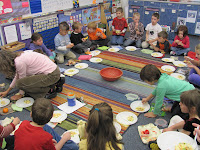In a classroom of twenty-four first and second grade learners, talk is abundant. Children converse with their parents, teachers and classmates during transitions, independent and group work time and during their free time.
Differences in talk are seen in individual children and during the different activities. Some children are more verbal by nature and are the one’s with their hands up during group or the one’s who need redirection during independent activities. Other children naturally talk less so their voice is encouraged during group activities as well as during their free time or individual work time.
Different strategies for encouraging verbal responses are utilized during a group activity. “Wait Time” allows more hands to be raised after a question is asked or, time for the respondent to collect her thoughts before responding. The teacher is conscious of rotating through the students in the group, looking for verbal participation by all. Clarifying ideas, supporting with new vocabulary and help in articulating their ideas, support the learners to be successful and more willing to participate orally. The use of open-ended and critical thinking questioning versus yes-no answers allows for a more meaningful response and more language can be elicited. Teacher responses to their answers are supportive and encouraging or suggestive of further query if the answer is vague or incorrect. There is a balance between spontaneous answers and the request for the students to take turns by raising their hands. I usually start by letting them answer without hands and then move to hands up so I can look for the quieter learners.
Students are encouraged to work together quietly during their independent work, supporting each other’s learning while not disturbing others. Children are resources for each other and clarity on an assignment is often achieved by asking a friend.
The teacher also helps children to socially engage orally during their free time by giving them the language necessary to navigate social situations like how to enter play, how to engage in play, and how to deal with negative interactions.
For the second graders-Elders in this class, this is their second year with this teacher and thus communication is that much easier. The Elders are asked to support the first graders-Youngers by modeling appropriate behaviors. As the class becomes familiar with each other more spontaneous language is heard and social interactions are flourishing. I noticed it took the quieter students over a month before they felt comfortable coming to me, instead of the teacher, for support. For the more mature or talkative students it took about half that time.
For those students who are less verbal and thus seemingly less engaged, it is important to follow up during guided practice to evaluate whether the student understands the verbal directions. Auditory processing issues or hearing deficits are considered. It is enlightening to see these students in situations outside of the classroom. Do they play with their peers? Do they offer suggestions to play or are they just following along? If not, this is an opportunity to increase their oral language skills in an area where they are more likely to be successful, especially if peers are positive playmates, helping them to ask for what they want or allowing the imaginative play to go their way.
We have been studying penguins, comparing and contrasting by size, habitat and other defining characteristics. Students are heard talking about which penguin is their favorite and why, what they look like and where they live. They bring in penguin paraphernalia and are generally excited about penguins. Because they have been immersed in penguins for a significant amount of time, through art, technology, literature, writing, math and science, it is a topic of spontaneous conversation that all the students are engaged in. Their peers in the other two primary classes also are studying penguins thus nests were created out in the playground’s rubber. Because of these studies there have been many opportunities for knowledgeable and comfortable oral language experiences.
Another opportunity in this classroom for student initiated conversation is during snack time. These 15-20 minutes are packed with potential. Kids sign up for news (sharing of personal things or ideas), book shares (describe book and why you like it and give to a friend to read), family meeting (classroom issues) and Happy Notes (previously written notes to friends that are read and delivered). These are the communications that are important to them. The topics revolve around fairness, friendship and fun. It is interesting to me that when the students have news to share they almost always start with indicating who might already know what is to be shared or “now one knows this but…” I believe this is a strategy they use to get started with their communication. I have used this strategy to help kids get started with their thought. For example, if I am supporting one child speaking to another I suggest a phrase as simple as, ”Hey, Henry…” In many cases this is enough to get them talking.
In general, I believe talking is a natural desire for children and adults alike. If we have interested listeners who care about what we say and want to know more, then we are rewarded and our communications increase. Thus showing we are good listeners through eye contact and relevant questioning, teachers and peers can support individual successes throughout a student’s day.



